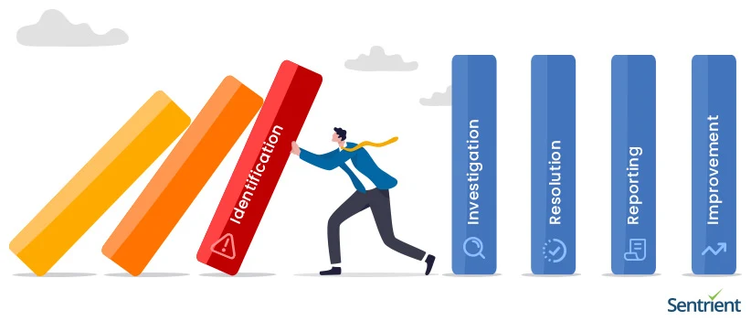In today’s fast-paced business environment, effective incident management is crucial for maintaining operational continuity and ensuring customer satisfaction. Australian businesses, in particular, face unique challenges and opportunities when it comes to managing workplace incidents. This blog post will explore the best practices for incident management, tailored specifically for Australian businesses, and highlight key features of Incident Management Software.
Incident management involves identifying, analysing, and responding to disruptions in everyday business operations, ranging from minor workplace incidents to reportable ones. Effective incident management helps businesses minimise downtime, reduce costs, and maintain government compliance. Australia’s healthcare, aged care, and NDIS sectors often require reliable incident management reporting solutions to fulfil regulatory reporting requirements.

Why Incident Management is Important for Australian Businesses
Australia’s diverse and dynamic business landscape necessitates robust incident management practices. Whether in the bustling cities of Sydney and Melbourne or the remote outback regions, businesses must be prepared to handle a wide range of incidents, including workplace accidents, bullying, compliance breaches and harassment. Moreover, Australia’s unique workplace regulatory environment and emphasis on safety and quality make incident management systems a critical component of business operations.
Best Practices for Incident Management
Establish a Clear Incident Management Process
A well-defined incident management process serves as the foundation for effective incident management. This incident management process should clearly outline the roles and responsibilities of team members, the procedures for reporting and responding to incidents, and the criteria for escalating incidents to higher levels of management.
Implement a Centralised Incident Management System
Using a centralised Incident Management Software allows businesses to track and manage incidents more efficiently. This system should provide real-time visibility into incident status, facilitate communication among team members, and generate reports for analysis and improvement.
Prioritise Incidents Based on Impact
Not all incidents are created equal. Prioritising incidents based on their impact on business operations and customer satisfaction helps ensure that the most critical issues are addressed first. This prioritisation can be based on factors such as the number of affected users, the severity of the disruption, and the potential financial impact.
Develop a Comprehensive Incident Response Plan
An incident response plan outlines the steps to be taken when an incident occurs. This plan should include procedures for identifying and assessing incidents, communicating with stakeholders, and implementing corrective actions. Regularly reviewing and updating the incident response plan ensures that it remains effective and relevant.
Conduct Regular Training and Drills
Training and drills are crucial for preparing team members to respond effectively to incidents. Regular training sessions help ensure that team members are familiar with incident management procedures and can act quickly and confidently in the event of an incident. Drills simulate real-world scenarios, enabling teams to practice their response and identify areas for improvement.
Foster a Culture of Continuous Improvement
Incident management is a crucial and ongoing process that involves the identification, response, and resolution of unforeseen events or disruptions within an organisation. It requires a cyclical approach of planning, preparation, response, and learning to continually improve and adapt to evolving challenges. By fostering a culture of continuous learning and improvement, businesses can effectively pinpoint the underlying causes of incidents, proactively implement preventive measures, and strengthen their overall incident management capabilities. This approach is essential for minimising the impact of incidents, enhancing organisational resilience, and ultimately ensuring the uninterrupted delivery of products or services.
Leverage Technology and Automation
Technology and automation can significantly enhance incident management processes. Automated monitoring and alerting systems can detect incidents in real-time, allowing for faster response times. Additionally, artificial intelligence and machine learning can help predict and prevent incidents before they occur.
Collaborate with External Partners
Collaboration with external partners, such as service providers, regulatory bodies, and industry associations, can provide valuable insights and resources for incident management. Establishing solid relationships with these partners helps businesses stay informed about industry best practices and regulatory requirements.
Key Features of Workplace Incident Management Software
To effectively manage incidents, businesses should consider using Workplace Incident Management Software that offers the following key features:
- Incident Tracking Software: Centralised tracking of incident details, status, Actions, Activities and responsibilities.
- Automated Alerts and Notifications: Real-time alerts to inform the right individuals promptly.
- Collaboration Tools: Platforms for real-time collaboration among team members.
- Incident Documentation and Analysis: Tools for documenting incidents and conducting post-incident analysis.
- Automation and Orchestration: Customisable workflows can automate repetitive tasks and trigger predefined responses. Incident templates are available to easily log different types of incidents. The system features a user-friendly task-based interface for assigning action items and linking incidents to risks managing the risk matrix as part of the organisation’s risk mitigation strategy.
- Reporting and Analytics: Insights into incident response performance, resolution times, and root causes. A detailed dashboard allows for drill-down and can show the time it takes to resolve an Incident.
- Security Logs and Access Control: Features to ensure secure incident handling: The incident management system should allow for visibility control and anonymous incident logging to protect employee privacy.
- Third-Party Integrations: Integration with existing systems and tools for seamless incident management.

Conclusion
Effective incident management is essential for maintaining business continuity and ensuring compliance. By implementing the best practices outlined in this blog post and leveraging the features of Workplace Incident Management Software, Australian businesses can enhance their incident management capabilities and be better prepared to handle any disruptions that come their way. Effective incident management can be critical for audit and compliance requirements for many Australian businesses that are required to maintain an incident register.
Key Takeaways
- Establish a clear incident management process
- Implement a centralised Incident Management Solution
- Prioritise incidents based on impact and compliance requirements
- Develop a comprehensive incident response plan which includes Risk Management
- Conduct regular Incident Audits and look for improvement possibilities
- Foster a culture of continuous improvement
- Leverage technology and automation
- Collaborate with external partners
By following these best practices and utilising online Incident Management Software, Australian businesses can improve their incident management processes and ensure a swift and effective response to any incident.





